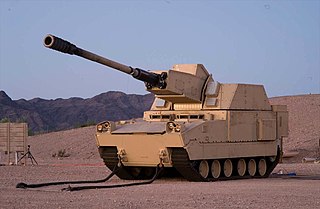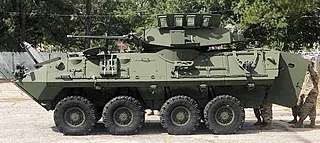Related Research Articles

The AAI RQ-7 Shadow is an American unmanned aerial vehicle (UAV) used by the United States Army, Australian Army, Swedish Army, Turkish Air Force and Italian Army for reconnaissance, surveillance, target acquisition and battle damage assessment. Launched from a trailer-mounted pneumatic catapult, it is recovered with the aid of arresting gear similar to jets on an aircraft carrier. Its gimbal-mounted, digitally stabilized, liquid nitrogen-cooled electro-optical/infrared (EO/IR) camera relays video in real time via a C-band line-of-sight data link to the ground control station (GCS).

The Special Atomic Demolition Munition (SADM), also known as the XM129 and XM159 Atomic Demolition Charges, and the B54 bomb was a nuclear man-portable atomic demolition munition (ADM) system fielded by the US military from the 1960s to 1980s but never used in combat.

Future Combat Systems (FCS) was the United States Army's principal modernization program from 2003 to early 2009. Formally launched in 2003, FCS was envisioned to create new brigades equipped with new manned and unmanned vehicles linked by an unprecedented fast and flexible battlefield network. The U.S. Army claimed it was their "most ambitious and far-reaching modernization" program since World War II. Between 1995 and 2009, $32 billion was expended on programs such as this, "with little to show for it"..

The XM1203 Non-Line-of-Sight Cannon (NLOS-C) was a 155 mm self-propelled howitzer. It was the lead vehicle for the U.S. Army's Future Combat Systems Manned Ground Vehicles program.

The LAV-25 is a member of the LAV II family. It is an eight-wheeled amphibious armored reconnaissance vehicle built by General Dynamics Land Systems and used by the United States Marine Corps and the United States Army.

The M982 Excalibur is a 155 mm extended-range guided artillery shell developed in a collaborative effort between the U.S. Army Research Laboratory (ARL) and the United States Army Armament Research, Development and Engineering Center (ARDEC). The Excalibur was developed and/or manufactured by prime contractor Raytheon Missiles & Defense, BAE Systems AB and other subs and primes in multiple capacities such as Camber Corporation and Huntington Ingalls Industries. It is a GPS and inertial-guided munition capable of being used in close support situations within 75–150 meters (250–490 ft) of friendly troops or in situations where targets might be prohibitively close to civilians to attack with conventional unguided artillery fire. In 2015 the United States planned to procure 7,474 rounds with a FY2015 total program cost of US$1.9341 billion at an average cost of US$258,777 per unit. By 2016, unit costs were reduced to US$68,000 per round. Versions that add laser-guidance capability and are designed to be fired from naval guns began testing in 2015. By October 2018, over 1,400 rounds had been fired in combat.
The XM1111 Mid-Range Munition (MRM) is a 120 mm precision guided munition developed for the Rheinmetall Rh-120 120mm gun used by several Western tanks. It was also intended to fulfill a requirement for Future Combat Systems (canceled) for a long-range, beyond line of sight (BLOS) tank munition.
The M93 Hornet mine was an American anti-tank mine. It was a wide-area mine, capable of attacking targets up to 100 meters away from its position.
The GBU-44/B Viper Strike glide bomb was a GPS-aided laser-guided variant of the Northrop Grumman Brilliant Anti-Tank (BAT) munition which originally had a combination acoustic and infrared homing seeker. The system was initially intended for use from UAVs, and it was also integrated with the Lockheed AC-130 gunship, giving that aircraft a precision stand-off capability. The Viper Strike design is now owned by MBDA.

The 53rd Weapons Evaluation Group is a United States Air Force unit that reports to the 53rd Wing. It is stationed at Tyndall Air Force Base, Florida. The unit is part of Air Combat Command.

The Ripsaw is a series of developmental unmanned ground combat vehicles designed by Howe & Howe Technologies for evaluation by the United States Army.
Project Scorpion is a multinational military modernization program which uses military-run experimentation for acquisition of new armaments. Project Scorpion also tests new military behaviors such as effects-based operations, network-centric warfare, and irregular warfare and civilian-military concepts.

The GBU-39/B Small Diameter Bomb (SDB) is a 250-pound (110 kg) precision-guided glide bomb that is intended to provide aircraft with the ability to carry a higher number of more accurate bombs. Most US Air Force aircraft will be able to carry a pack of four SDBs in place of a single 2,000-pound (910 kg) bomb. It first entered service in 2006. The Ground Launched Small Diameter Bomb (GLSDB) was later developed to enable the SDB to be launched from a variety of ground launchers and configurations.
The M7 Spider is a networked United States anti-personnel munitions system that provides a secure remote command and control capability of up to 1500 meters for a hand-emplaced munition field. The system was developed by Alliant Techsystems (ATK) with its joint venture partner Textron Systems as a part of the Non-Self-Destruct Alternative (NSD-A) program and is intended to replace the Matrix remote trigger system currently deployed in Iraq which works with pre-existing mines like the M18 Claymore. Day & Zimmermann and General Dynamics are prime subcontractors.

The Fleet-class unmanned surface vessel, also called the Common Unmanned Surface Vessel (CUSV) and later the Mine Countermeasures Unmanned Surface Vehicle, is an unmanned surface vessel designed for the United States Navy to be deployed from Freedom and Independence-class littoral combat ships and intended to conduct mine and anti-submarine warfare missions. As of 2012 four units of the class have been built; the first was delivered to the U.S. Navy in 2008.

The Textron AirLand Scorpion is an American jet aircraft proposed for sale to perform light attack and intelligence, surveillance and reconnaissance (ISR) duties. It is being developed by Textron AirLand, a joint venture between Textron and AirLand Enterprises. A prototype was secretly constructed by Cessna at their Wichita, Kansas facility between April 2012 and September 2013 and first flown on 12 December 2013.

A loitering munition is a kind of aerial weapon with a built-in munition (warhead), which can loiter around the target area until a target is located; it then attacks the target by crashing into it. Loitering munitions enable faster reaction times against hidden targets that emerge for short periods without placing high-value platforms near the target area and also allow more selective targeting as the attack can be changed mid-flight or aborted.
The SCORPION(Self CORrecting Projectile for Infantry OperatioN) program was a research initiative funded by the U.S. Defense Advanced Research Projects Agency (DARPA) and led by the U.S. Army Research Laboratory (ARL) and the Georgia Institute of Technology to integrate micro adaptive flow control (MAFC) technology into small caliber munitions to develop spinning, guided projectiles. The program led to the creation of a spin-stabilized 40 mm grenade, also called SCORPION, that could propel itself to its target by using calculated micro-jet bursts of air to correct its path once launched.
The Next Generation Combat Vehicle (NGCV) is a United States Army program intended to procure a variety of armored vehicles to add new capabilities to Army units and replace existing platforms that are nearing the end of their service life. The program covers the following systems:

UVision Air Ltd. is an Israeli defense technology company established in 2011. It engaged in the development, manufacturing and sales of advance missiles and loitering munition systems for land, air, and naval military forces. The company’s products, called HERO, are designed for targeted attacks against a variety of threats at various ranges.
References
- 1 2 3 4 5 Pernin, Christopher; Axelband, Elliot; Drezner, Jeffrey; Dille, Brian; Gordon IV, John; Held, Bruce; McMahon, Scott; Perry, Walter; Rizzi, Christopher; Shah, Akhil; Wilson, Peter; Sollinger, Sollinger (2012). Lessons from the Army's Future Combat Systems Program (PDF) (Report). RAND Corporation. Archived (PDF) from the original on March 25, 2020 – via Defense Technical Information Center.
- 1 2 Defense Acquisitions: Assessments of Selected Weapon Programs (PDF) (Report). United States Government Accountability Office. January 2004. GAO-11-233SP. Archived (PDF) from the original on June 23, 2020 – via Defense Technical Information Center.
- 1 2 Christie, Thomas (March 2011). Director, Operational Test and Evaluation FY 2004 Annual Report (PDF) (Report). The Pentagon. Archived (PDF) from the original on March 5, 2020 – via Defense Technical Information Center.
- 1 2 Middlebrooks, Sam (February 2010). An Annotated Bibliography of MANPRINT-Related Assessments and Evaluations Conducted by the U.S. Army, 2nd Edition: 1953 to 2009 Volume II – MANPRINT Assessment and Evaluations (PDF) (Report). The U.S. Army Research Laboratory. ARL-SR-159. Archived (PDF) from the original on March 26, 2020 – via Defense Technical Information Center.
- 1 2 "Textron Systems will showcase XM1100 Scorpion ground-based networked munition at Defexpo 2201144". Army Recognition. January 22, 2014. Retrieved January 7, 2020.
- ↑ "U.S. Landmine Policy". U.S. Department of State Archive. January 20, 2009. Retrieved January 7, 2020.
- ↑ "Along Came a Spider: The XM-7 RED Mine". Defense Industry Daily. August 27, 2013. Retrieved January 7, 2020.
- ↑ "Textron Defense Systems' XM1100 Scorpion(TM) Completes Simulated Urban Environment Tests". Textron. October 12, 2009. Retrieved January 7, 2020.
- ↑ "XM1100 Scorpion Network Platform Completes Design Review". Defence Talk. July 16, 2009. Retrieved January 7, 2020.
- ↑ "XM1100 Scorpion Completes Successful End-to-End Live Fire Testing" (PDF). Retrieved January 7, 2020.[ permanent dead link ]
- ↑ "XM1100 Scorpion Scores Hits in All Live Fire Tests". Textron. December 6, 2010. Retrieved January 7, 2020.
- ↑ Smith, Nathan (June 13, 2014). Joint Countermobility Capabilities in the Department of Defense (MSc). U.S. Army Command and General Staff College – via Defense Technical Information Center.